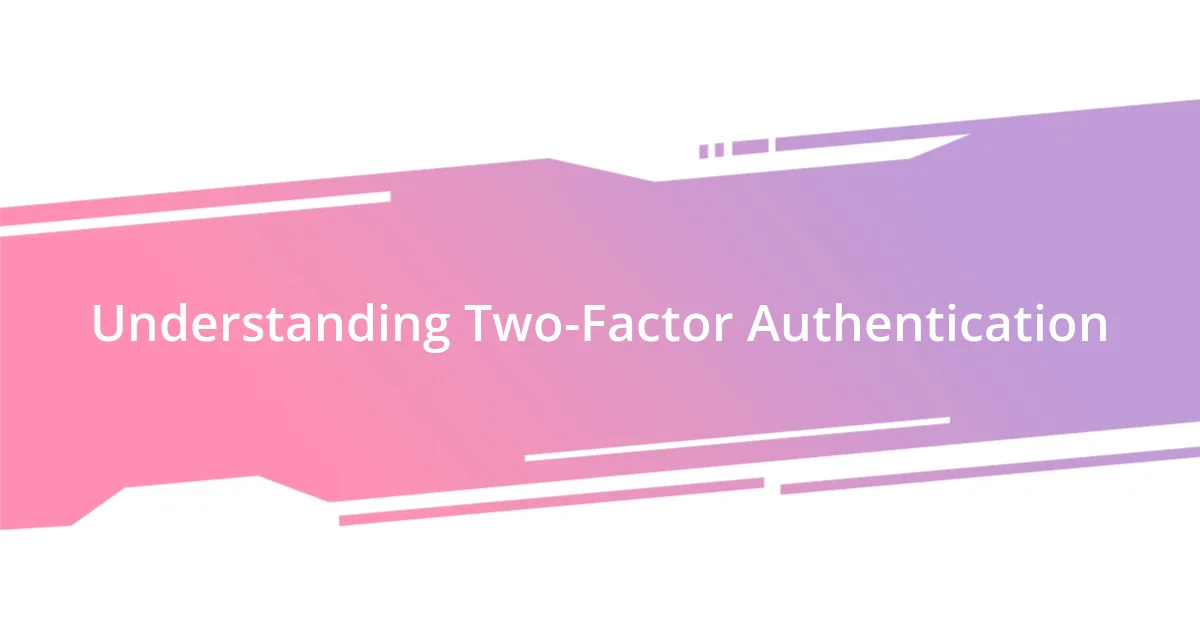Key takeaways:
- Two-factor authentication (2FA) adds an extra layer of security, reducing vulnerabilities associated with relying solely on passwords.
- Choosing the right authentication app is crucial; factors like compatibility, user experience, and backup options enhance security and usability.
- Regularly manage and update backup codes and recovery options to maintain access and security, while staying informed about evolving security threats is essential.

Understanding Two-Factor Authentication
Two-factor authentication (2FA) is like adding an extra lock to your front door; it significantly beefs up your security. In my experience, knowing that I require something I have—like my phone—along with something I know, such as my password, gives me peace of mind. How often have you worried about whether your accounts are secure? I used to feel anxious after hearing stories of data breaches, but implementing 2FA turned that anxiety into confidence.
When you enable 2FA, you’re not just following a trend; you’re taking tangible steps to protect yourself. I remember the first time I set it up for my email account. It felt like a small victory! That added layer made me realize how vulnerable we are online without such measures. Have you ever had that nagging feeling that your password just isn’t enough? Trust me, once you experience the ease and security of 2FA, you’ll wonder how you ever lived without it.
It’s fascinating to see how different methods of 2FA work, from SMS codes to authenticator apps. I had my doubts when I first switched from SMS to an authenticator app, thinking it might be cumbersome. However, I found that it not only streamlined my logins but also kept everything more secure. Have you explored different options for 2FA yet? Each choice can give you varying levels of security, and your comfort with them is key to maintaining your online safety.

Benefits of Two-Factor Authentication
Two-factor authentication offers a remarkable boost to account security. I recall a moment when my friend’s social media account got hacked because he relied solely on a password. The feeling of vulnerability hit home—the fact that a single password wasn’t enough. With 2FA, I now experience a safeguard that feels like an invisible shield around my online presence, meaning I can browse and communicate with greater peace of mind.
Another significant benefit is how it reduces the risk of unauthorized access. After enabling 2FA on my banking app, I was pleasantly surprised by the added layer of protection. I once received an alert asking for a code while I was on vacation; I immediately knew something was off. Thankfully, 2FA stopped any potential intruder in their tracks. The relief of knowing that I was alerted in real-time—before any damage could be done—was genuinely empowering.
Furthermore, it fosters a proactive approach to security. I now think differently about my personal information. Whenever I sign up for a new service, I make it a point to check if they support 2FA. This habit not only makes me feel like I’m taking charge of my security but also encourages others in my circle to do the same. When I discuss how two-factor authentication has reshaped my online experience, I see sparks of interest from friends and family, and it’s satisfying to know I’m inspiring them to level up their own protections.
| Benefit | Description |
|---|---|
| Increased Security | It adds an extra layer beyond just passwords. |
| Real-Time Alerts | Notify users of unauthorized access attempts immediately. |
| Encourages Proactive Behavior | Motivates users to prioritize security measures. |

Choosing the Right Authentication App
Choosing the right authentication app can feel overwhelming, but I’ve found it immensely rewarding once I settled on one that clicked for me. It’s essential to review the features and user experience of different apps. When I first compared them, the simplicity of interface stood out to me; I wanted something efficient that wouldn’t complicate my daily routine. A well-designed app not only simplifies the login process but also enhances safety.
Here are some key factors to consider:
- Compatibility: Ensure the app works with your most-used platforms.
- User Experience: Look for an intuitive design that makes authentication quick and easy.
- Backup Options: Check if the app offers recovery codes or backup methods in case you lose access.
- Security Features: Investigate additional features, such as biometric verification.
- Community Trust: Read reviews or personal experiences from others to gauge reliability.
Switching apps can be a challenge, but I always remind myself that my security should never be an inconvenience. When I made my final choice, I felt as if I was investing in my digital future. After all, finding the right authentication app should not just be about choice; it’s about finding the right fit that aligns seamlessly with how I work online.

Setting Up Two-Factor Authentication
Setting up two-factor authentication (2FA) can initially feel like a daunting task, but I assure you, the peace of mind it brings is incredibly worth it. When I first tackled this, I faced a few hiccups—like forgetting which device I selected for my codes. It’s a good idea to have a clear plan before you start, such as keeping your primary phone handy, as it often becomes your go-to for authentication codes.
As I walked through the setup process, I realized how intuitive many platforms have made it. I vividly remember enabling 2FA on my email account. In just a few clicks, I received a verification code via text. This aspect of the setup helps eliminate guesswork. I felt a tiny thrill of accomplishment with every step completed; it was like constructing a digital fortress around my most sensitive information.
Don’t overlook the importance of backup options while setting up. When I first enabled 2FA, I opted for text messages, but soon after, I learned about the benefits of using an authenticator app. It felt liberating to know I could access my codes even when I wasn’t connected to the internet. So, ask yourself: how often are you on the go? Having a backup method is like having an insurance policy for your access; it secures your entry in any situation.

Managing Backup Codes Effectively
Managing backup codes effectively is crucial for maintaining access to your accounts in a tight spot. I always make it a habit to store those codes in a secure but accessible location. One time, I tucked them away in a password manager, which felt like a smart move. However, I later realized that I also needed a printed copy stashed in my safe, just in case my device failed. I can’t tell you how comforting it felt to know that I had redundancy in place. Have you considered what might happen if you lose access to your device?
Regularly reviewing your backup codes is another good practice I’ve adopted. I learned this the hard way when I found old codes that were no longer valid after changing authentication methods. To keep this manageable, I set a reminder every few months to update and verify them. This not only keeps my access streamlined but also gives me peace of mind knowing that everything is current. Consistency is key, right? How often do you think about revisiting your security measures?
Don’t underestimate the emotional aspect of managing backup codes. The first time I faced a situation where I forgot my phone and desperately needed to log in, anxiety kicked in. Since then, I’ve developed a more proactive approach. Keeping a digital copy and a physical one gives me a sense of control over my online security. Remember, when it comes to safeguarding your accounts, preparedness can turn a stressful situation into a mere inconvenience.

Common Mistakes to Avoid
One common mistake I’ve encountered is neglecting the security of recovery options. I once set up 2FA and felt confident because I added a recovery email. However, it hit me when I tried to access my account after being locked out—my recovery email wasn’t secure enough. This experience taught me that every backup option needs a layer of protection. Have you ever thought about how fragile your recovery methods might be?
Another pitfall is overlooking the complexity of passwords in relation to 2FA. When I first implemented two-factor authentication, I assumed the process alone would be enough to safeguard my accounts. I quickly learned that without strong, unique passwords, all my efforts could easily crumble in the face of a cyber-attack. So, it begs the question: Are your passwords reflecting the same level of security you expect from your 2FA?
Lastly, one of the biggest mistakes I’ve made was treating my authenticator app casually. I remember thinking, “It’s just an app.” But when my phone died without a backup, I was left in a bind. Now, I ensure I have a reliable backup of my authenticator app and that it’s synced across devices. How would you feel if your access depended solely on a single point of failure? Being proactive can save you from unnecessary stress down the road.

Best Practices for Secure Usage
When it comes to best practices for secure usage of two-factor authentication, I find that enabling app-based verification usually offers the most robust security. I learned early on that SMS codes can be intercepted, leaving my accounts vulnerable. The first time I had to deal with a potential breach, switching to an authenticator app felt empowering. Have you ever felt that rush of confidence knowing you’ve taken a step to solidify your security?
Another key aspect is ensuring that I regularly educate myself on the evolving landscape of security threats. There was a time when I thought I had everything in order, only to discover that some older methods of 2FA were being compromised. That’s why I subscribe to security updates and follow tech blogs—keeping informed feels like wearing armor against potential threats. How often do you update your knowledge about the very tools you rely on?
Finally, I can’t stress enough the importance of keeping all my devices updated. Each time I postpone an update, I can’t shake off the feeling of vulnerability. It’s like walking through a digital minefield without checking for dangers first. I remember feeling panic after realizing an outdated device was the weak link in my security system. Now, I make it a point to schedule updates regularly, treating it as a vital part of my security routine. What measures do you take to safeguard against unexpected vulnerabilities?














